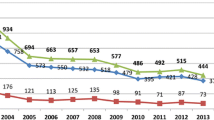Abstract
As part of a national study of surgical departments in Israel, cardiac surgery patients undergoing open heart surgery between 1987 and 1989 were followed-up prospectively. Of these, 1,046 patients had coronary artery bypass grafting (CABG) and are the subject of this report. The six-months mortality after surgery was 12.9% among 202 women and 4.1% among 844 men. Female gender was an independent predictor of mortality even after controlling for the effect of 14 putative risk factors. The adjusted relative risk for mortality in women compared to men was 2.79 (1.5–5.2). In an attempt to understand this excessive mortality among women, a detailed analysis in one of the participating hospitals revealed differences associated with surgical technique by gender, such as proportion of patients with entirely venous grafting vs internal mammary artery grafts (IMA). Thirty percent of women vs 4.8% of men had entirely venous grafting. Adjusting the data for differences in the proportion of venous grafting has obliterated the difference in mortality between the genders in that hospital. We suggest that interventions to reduce mortality among women should involve a more careful choice of female candidates for CABG surgery, as well as introduction of modifications in the operating technique.
Similar content being viewed by others

References
Goldbourt U, Kark JD. The epidemiology of CHD in the ethnically and culturally diverse population of Israel. Isr J Med Scien 1982; 18: 1077–1097.
World Health Organization, Health in Europe. Copenhagen: WHO Regional publication, European series, No. 56, 1994.
Kennedy JW, Kaiser GC, Fisher LD, et al. Multivariate discriminant analysis of the clinical and angiographic predictors of operative mortality from the collaborative study in coronary artery surgery (CASS), J Thorac Cardiovasc Surg 1980; 80: 876–887.
Kennedy JW, Kaiser GC, Fisher LD, et al. Clinical and angiographic predictors of operative mortality from the collaborative study in coronary artery surgery (CASS). Circulation 1981; 63: 793–802.
Fisher LD, Kennedy JW, Davis KB, et al. Association of sex, physical size, and operative mortality after coronary artery bypass in the coronary artery surgery study (CASS). J Thorac Cardiovasc Surg 1982; 84(3): 334–341.
Richardson JV, Cyrus RJ. Reduced efficacy of coronary artery bypass grafting in women, Ann Thorac Surg 1986; 42(suppl): S16-S21.
Douglas JS, King SB, Jones EL, et al. Reduced efficacy of coronary bypass surgery in women, Circulation 1981; 64: II11-II16.
Teoh KH, Christakis GT, Weisel RD, et al. Increased risk of urgent revascularization. J Thorac Cardiovasc Surg 1987; 93: 291–299.
Parsonnet V, Dean D, Bernstein AD. A method of uniform stratification of risk evaluating the results of surgery in acquired adult heart disease. Circulation 1989; 79(6): I3-I12.
The Society of Thoracic Surgeons, National cardiac surgery data base, January 1993.
O'connor GT, Morton JR, Diel MJ, et al. Differences between men and women in hospital mortality associated with coronary artery bypass graft surgery. Circulation 1993; 88: 2104–2110.
Loop FD, Golding LR, MacMillan JP, Cosgrove DM, Lytle BW, Sheldon WC. Coronary artery surgery in women compared with men: Analyses of risks and long-term results. J Am Coll Cardiol 1983; 1(2): 383–390.
Hannan EL, Bernard HR, Kilburn HC, O'Donnell JF. Gender differences in mortality rates for coronary artery bypass surgery. Am Heart J 1992; 123: 866–872.
Simchen E, Wax Y, Pevsner B, et al. The Israeli study of surgical infections(ISSI): I. Methods for developing a standardized surveillance system for a multicenter study of surgical infections. Infect Control Hosp Epidemiol 1988; 9: 232–240.
Simchen E, Wax Y, Pevsner B. The Israeli study of surgical infections (ISSI): II. Initial comparisons among hospitals with special focus on hernia operations. Infect Control Hosp Epid 1988; 9: 241–249.
Khan SS, Nessim S, Gray R, Czer LS, Chaux A. Increased mortality of women in coronary artery bypass surgery: Evidence for referral bias. Ann Int Med 1990; 112: 561–567.
Ramstrom J, Lund O, Cadavid E, et al. Multiarterial coronary artery bypass grafting with special reference to small vessel disease and results in women. Eur Heart Journal 1993; 14: 634–639
Ayanian JZ, Epstein AM. Differences in the use of procedures between women and man hospitalized for coronary heart disease. N Eng J Med 1991; 325: 221–225.
Edwards FH, Clark RE, Schwartz M. Impact of internal mammary artery conduits on operative mortality in coronary revascularization. Ann Thorac Surg 1994; 57: 20–26.
Author information
Authors and Affiliations
Rights and permissions
About this article
Cite this article
Simchen, E., Israeli, A., Merin, G. et al. Israeli women were at a higher risk than men for mortality following coronary bypass surgery. Eur J Epidemiol 13, 503–509 (1997). https://doi.org/10.1023/A:1007349230374
Issue Date:
DOI: https://doi.org/10.1023/A:1007349230374



